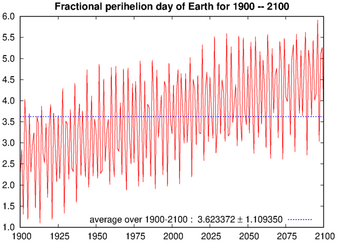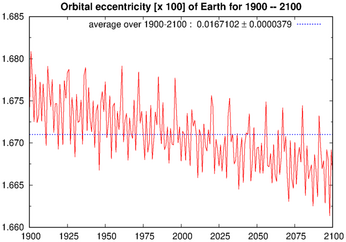UV index and UV dose: varying Sun-Earth distance
data version 2.x

UV index and UV dose: varying Sun-Earth distance
|

|
| Main data product description page |
Varying Sun-Earth distance
Because the Earth follows an elliptic orbit around the Sun, the Sun-Earth distance varies throughout the year and this has to be accounted for in the UV index and UV dose calculation: the closer to the Sun, the higher the UV radiation. WithD_0the average distance, the correction factor is:f(D) = ( D_0 / D ) ^2This factor is computed with Kepler's first law from the date of the measurement and from the perihelion date and the eccentricity of the Earths orbit for the measurement year (the perihelion is the point in the Earths orbit where it is closest to the Sun).The latter two are determined from a table of the Earth perihelion data for the years 1901-2100 (the source is discussed below), where the eccentricity is 1 minus the distance at perihelion -- see the two graphs below. The value of
f(D)varies between about 1.034 on 3 Jan. and about 0.967 on 3 July.We assume that the correction factor
f(D)has no error, i.e. that the perihelion of the Earths orbit is known very well.


The perihelion date and the eccentricity of the Earths orbit for the measurement year in the period 1901 to 2100 (red) and the average over that period (blue).
[ download figures as PDF ]
Meanwhile, the data at Cococubed has been updated to include more years; see: Cococubed Ephemeris page (search for "perihelion").
![]() last modified: 3 December 2020
last modified: 3 December 2020
data product contact:
Jos van Geffen & Michiel van Weele &
Ronald van der A
Copyright © KNMI / TEMIS